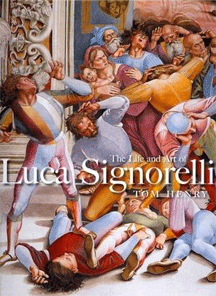By Svetlana Alpers
There are two reasons to read this book. First, to get acquainted with a strange and wonderful painter who has been described as “the least well-known major artist of the Renaissance.” Secondly, to celebrate the old-fashioned monograph, a style of scholarly presentation and publishing that is, for economic reasons, nearing its end.
Luca Signorelli (1450-1523) connects the taut freshness of fifteenth century painters to the ample accomplishments of the sixteenth century. He trained with Piero della Francesco, and his early fresco (usually overlooked) on the lower wall of the Sistine Chapel and his mature ones on walls of the Chapel Nova of the Cathedral at Orvieto fascinated both Raphael and Michelangelo.
Signorelli is not an easy painter to like. His works can be crowded. It is less horror vacui than a desire to fit too much in. At the center of his interests is the male nude─from boisterous infant thru athletic youth to frail ancient. The male nude is focused on, in the fifteenth century way, as basic to the making of art. He was also an extravagant colorist, who fancied clothes (in life as in art) and the rendering of natural details—landscape, flowers in a glass—made possible by the new oil paint.
The glory of Orvieto is that the display of multiple nudes was essential to the theme─the End of the World and the Last Judgment. Entering the chapel one is overwhelmed by the narrative imagining of us and of our end: damnation with flying devils on the attack and salvation with bodies breaking the crust of the earth. One settles down to let one’s eyes work their way through. That takes time. Conservation of the frescoes at Orvieto was completed in the 1990s. If you go, be bold and ask someone to turn off the artificial lights to see it as was painted to be seen.
Tom Henry’s book is a classic of its kind, though leaner by virtue of the fact that a catalogue of Signorelli’s work─of which he is a co-author─was published a decade ago and that all of the documents can be found online. Beginning with the artist’s checkered reputation and concluding with his curious final works, the chronological presentation deals with the life, the patrons, the style and iconography. The views of other scholars are considered in the accustomed mode which is at once formal and conversational. The lay-out perfected by Yale University Press is a double-columned text with many large color illustrations, each chapter opening with a full-page detail on the facing page. A volume like this gives you all the historical and visual knowledge necessary to go forth and look at Signorelli’s paintings on your own.
Svetlana Alpers, an artist, critic and renowned art historian, is professor emerita of the history of art at the University of California, Berkeley and a visiting scholar in the Department of Fine Arts at New York University.




